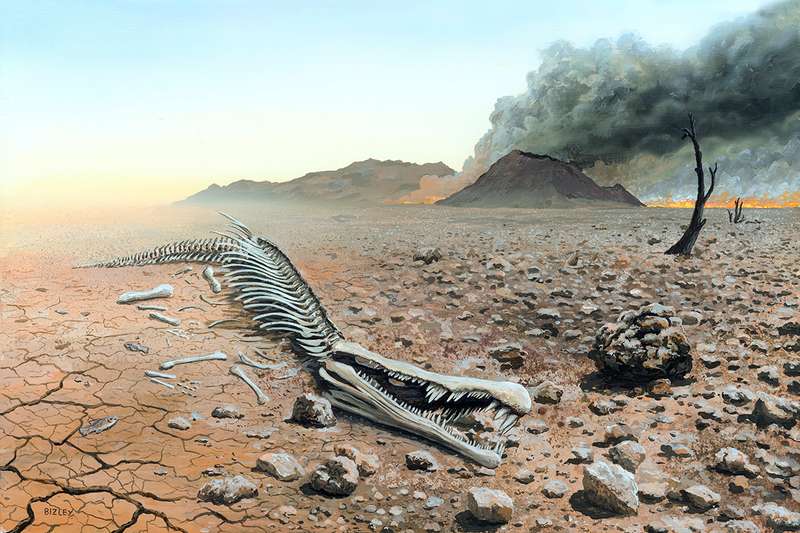Throughout the story of life on Earth there have been periods of great disruption that resulted in the extinction of vast swathes of the diversity of life.
The Five big extinction events, events that caused more than 75% of species to be wiped out, are generally recognised as these …
| Event | When | Impact | Cause |
| Ordovician–Silurian extinction events | 450–440 Ma | 86% of species | Global cooling and sea level drop, possibly caused by a Gamma-ray burst |
| Late Devonian extinction | 375-360 Ma | 75% of species | Viluy Traps[ |
| Permian–Triassic extinction event | 252 Ma | 96% of species | Siberian Traps; Wilkes Land Crater;[ Anoxic event |
| Triassic–Jurassic extinction event | 201 Ma | 80% of species | Central Atlantic magmatic province;[ impactor? |
| Cretaceous–Paleogene extinction event | 66 Ma | 76% of all species | Chicxulub impactor;[11] Deccan Traps?[12] |
The last one is the one we are all perhaps familiar with. That’s the event that killed all the dinosaurs.
There is however one other mass extinction event. It is often referred to as the 6th Mass extinction event. This is it …
| Event | When | Impact | Cause |
| Holocene extinction | Now | ? | Humans[ |
Our impact is global. There have been extinctions of species on every land mass and in every ocean. By about 2100, just 81 years from now, our impact will have reached a point at which we will have been wholly and completely responsible for the elimination of 50% of species. It does not stop at that point, the impact will simply continue.
It is not yet end-game, we are conscious that this is happening and so we can also consciously take steps to mitigate what is happening …
- 189 countries have signed the Convention on Biological Diversity (Rio Accord)
- This commits them to committed to preparing a Biodiversity Action Plan,
- We are also becoming increasingly conscious of climate change and are already starting to strive to address that.
Will it all be too little and too late?
That is the huge unknown, and yet there is still a window of opportunity that remains open, and so there rests hope.
If we do nothing, what happens then, how long will it take for life to recover?
Study: Morphospace expansion paces taxonomic diversification after end Cretaceous mass extinction
This is a new study that was published on 8th April within Nature Ecology and Evolution.
Their question
How long it will take for biodiversity and ecosystem functionality to recover after negative anthropogenic effects subside. To put that another way, once we are gone, how long will it take for life to bounce back?
We have an actual example to study
The Cretaceous–Palaeogene (K–Pg) mass extinction, caused by the impact of an asteroid on the Yucatán Platform in the southern Gulf of Mexico, was the most recent and most rapid of the five major mass extinctions and is perhaps the only major event in Earth history that happened faster than modern climate change. Thus, it provides a unique analogue for future recovery from rapid extinction.
How long did the diversity of life take to recover?
The initial early Danian burst in diversity only added about 20 species—less than one-quarter of pre-extinction diversity. Global richness increased unsteadily throughout the Palaeocene, and did not begin to approach even mid-Cretaceous levels until the Palaeocene–Eocene boundary 10 Myr later. The full recovery of species or genus diversity took more than 20 Myr, into the Middle Eocene, at which point it nearly matched the soaring heights of the Late Cretaceous.
That is not the only example
Genus-level macrofaunal diversity data show that a 10-Myr delay in elevated rates of origination is a feature of all mass extinctions.
Why does it take so long?
Although ecological niches can be conceptualized as slots in an ecosystem that different organisms can fit into, they are actually created by, and are thus inseparable from, the organisms that occupy them. In other words, organisms themselves construct the environments they inhabit. This can be more properly conceived of as morphospace.
Newly colonized morphospace can serve as a jumping-off point for further evolutionary innovation, which in turn opens additional ecospace, and so on.
The idea being explored by this paper is this: time is needed to reconstruct morphospace within ecosystems,. They use the term “the morphospace reconstruction hypothesis” to describe this.
What did they find?
Rapid reoccupation within the vacant open-ocean ecospace during the Early Palaeocene. In other words, after the extinction event there was a ‘refilling’ of vacant niches, but the diversity was narrow.
What came next were subsequent Palaeocene radiations that were driven by new evolutionary innovations that opened new morphospace.
What does this all mean?
Evolution has a speed limit.
What needs to happen is this.
Diversification is limited by the need to rebuild morphospace, which provides the scaffolding on which to evolve new species.
What comes next?
Life will recover from the human impact, however some ecological niches lost due to anthropogenic climate change will never reappear. While the future biosphere may eventually regain pre-Anthropocene numerical biodiversity levels, it will be significantly different from the biosphere in which we evolved and presently co-exist. This recovery will probably take millions of years.
